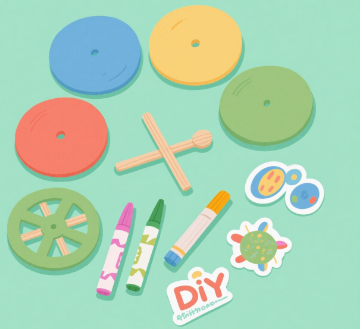DIY projects ignite imagination, encourage skill-building, and foster personal expression. Yet, one common roadblock for creators—both beginners and seasoned crafters—is decision fatigue. With infinite possibilities, even simple choices like “What should I make today?” or “Which material should I start with?” can become paralyzing. Wheel games for DIY projects are emerging as a delightful and effective solution to this challenge—turning choice into chance, and hesitation into action.
Break Through Creative Blocks with Spinning Decision Tools
When you’re overloaded with options, creativity can stall. This isn’t just anecdotal—a 2010 study published in the Journal of Personality and Social Psychology confirmed that making too many decisions in a short time diminishes both motivation and performance (Baumeister et al., 2010). Wheel games for DIY projects counteract this effect by offloading decision-making to an interactive, gamified process.
Creators can use a digital wheel to randomize:
- Craft types (e.g., woodworking, paper crafts, home decor)
- Tools or materials (e.g., glue gun, felt, recycled items)
- Themes (e.g., seasonal decor, upcycling, gifting)
- Time limits (e.g., “complete in 30 minutes” challenges)
This randomized approach injects spontaneity and removes analysis paralysis, which aligns with psychological findings in game-based learning theory—notably, that randomness can boost creativity by forcing people out of habitual patterns (Gee, 2003).

Tapping into the Maker Movement’s Need for Fun and Flow
The DIY community, especially among Gen Z and millennials, increasingly seeks experiences over rigid tutorials. According to a 2023 Etsy Marketplace Report, 68% of shoppers favor DIY kits and ideas that feel “surprising or interactive,” rather than step-by-step instructions. Wheel games fit this mold perfectly, making the project selection process feel more like play than pressure.
Wheel-based DIY generators can even be customized for:
- Eco-conscious crafting: Spin for upcycled project ideas.
- Family bonding: Include age-based difficulty levels and tasks.
- Holiday crafts: Let the wheel decide your seasonal decor projects.
From Classroom to Craft Room: The Educational Edge
Educational psychology supports gamified learning environments as highly effective. A 2021 meta-analysis in Computers & Education highlighted that gamification, especially with randomized mechanics, significantly improves user engagement and knowledge retention (Sailer & Homner, 2021). When you spin a wheel to decide on your DIY focus, you’re not just making—you’re learning how to adapt quickly and solve problems under creative constraints.
This makes wheel games for DIY projects an ideal tool for:
- Classroom makerspaces
- Online DIY tutorials
- Creative therapy sessions
- DIY content creators looking to spice up their livestream or TikTok content
Elevate Social Media Content with Spontaneity
With platforms like TikTok and Instagram Reels prioritizing unexpected, engaging content, DIY influencers are now using wheel games to add dynamic tension. “Spin the Wheel to Choose My Craft Challenge” is a growing trend, often paired with countdown timers and limited resources.
This aligns with digital marketing insights from HubSpot’s 2024 Social Media Trends Report, which identified interactive content formats as outperforming static posts in engagement by 47%.
Creators can amplify this by sharing their wheel results with their audience, inviting followers to spin next, or voting on what the next challenge should include.
How to Build Your Own Wheel Game for DIY Projects
Whether you’re a solo creator or a community educator, building a custom wheel game is simple and impactful. Platforms like SpinTheWheel.app offer editable wheels that can be tailored with text, images, or even embedded audio cues.
Here’s how to get started:
- Define categories (craft type, materials, challenge theme).
- Add fun options like “Use only one hand!” or “Make it wearable!”
- Set parameters—number of spins, re-spin rules, difficulty.
- Share the results, or better yet, livestream the spin for real-time participation.
By embracing the element of chance, you not only fuel your own creative flow but invite others to join in the unpredictability—a key driver of viral content and collaborative fun.
Conclusion: Chance Sparks Choice
The beauty of DIY lies in freedom—but sometimes, too much freedom leads to friction. Wheel games for DIY projects bring structure to spontaneity, turning randomness into a powerful ally for decision-making, inspiration, and joy. They are more than just novelties—they’re tools grounded in cognitive science, backed by trend data, and tuned to modern makers’ needs.
Whether you’re a beginner or a seasoned artisan, the spin of a wheel might just be the spark your next project needs.
Bring your creativity full circle—with SpinTheWheel.
About the Designer
Jessie Lin is the lead content designer at SpinTheWheel, with a background in behavioral psychology and game design. She has consulted for educational platforms and DIY networks across the U.S. and Asia, specializing in user engagement mechanics that blend fun with functionality. Her passion is making random feel meaningful—and she believes the right spin can unlock anyone’s inner maker.